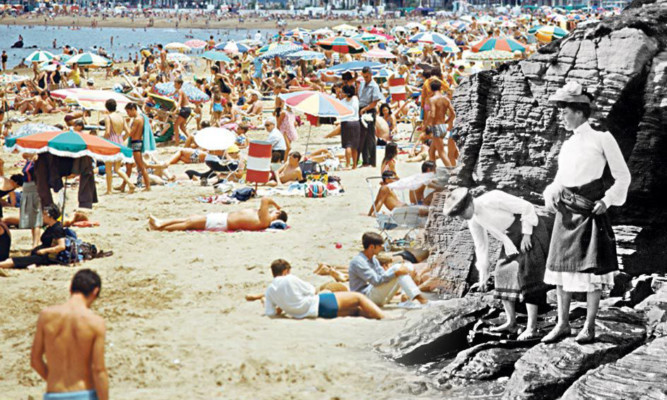
Sun, sea and the sands of time.
Thomas Cook began “conducted tours to the Continent” in May, 1865. The first organised overseas package holiday followed an earlier UK experiment with 500 people getting a tour of Scotland for one guinea (£1.05).
By the 1870s Cook’s Tours were offering trips to every corner of the world, including a 212-day round the world tour for 200 guineas.
Early package tourists had the same gripes as today’s seasoned travellers passport controls, poor foreign food and the fact that the locals didn’t speak English.
We look at our package holiday through the decades.
1950s
Only 1% of Brits had been abroad on holiday as the decade started, but Horizon Holidays pioneered mass package holidays in 1950 with charter flights to Corsica.
Aviation rule changes in 1954 and relaxed border controls led to cheaper flights on ex-wartime planes and the birth of the modern-day package.
Southern European countries, desperate for post-War cash, threw up hotels and Spanish resorts flourished as BEA opened a route to Valencia in 1957.
The Costa Brava, Majorca, Corsica and Greece were early favourites.
1960s
The real beginnings of boom time with two-week Thomson Holidays packages available for £50.
Hotels realised we wanted a home from home so there was no tapas, just British fare.
Thomson’s Sky Tours brochures told us how to speak to locals and even how many handkerchiefs to pack.
Euravia were one of the first charter airlines, with flights from Manchester.
Spanish resorts of the time were a world away from the dense high-rises that were to follow, with entertainment promises of “dancing twice a week in a discotheque or ballroom.”
1970s
British seaside favourites took a pounding as we swapped Blackpool for Benidorm, enticed by TV programmes such as Wish You Were Here?
Even during the school holidays you could get a fortnight in the roasting Spanish sun for under £80, or about £700 today.
Crete and the Algarve were the new top destinations.
But with boom came bust. TV bulletins and newspapers were full of bad headlines in 1974 when the second-largest tour operator Court Line, which had famous brands Horizon and Clarksons, collapsed.
Confidence in packages was shattered when 50,000 tourists were stranded overseas and 100,000 faced losing deposits.
Sir Freddie Laker’s Skytrain in 1977 offered flights to New York from £59 and the start of no-frills air travel made America an alternative to Greece and Spain.
1980s
BA launched its first package holiday to Australia and for hundreds of thousands a thumb through their Sovereign brochure was a pre-holiday essential.
But as Brits we continued to love familiarity with Gibraltar and Malta among the most popular spots as we still wanted bucket and spade holidays, but with guaranteed sun.
Bargain hunters looked east as Yugoslavia devalued its currency, bidding for Western visitors. Yugotours tempted millions to head for Pula, Split and Dubrovnik.
Winter breaks started to take off, with skiing packages soaring in popularity.
1990s
By the ’90s 56% of the 27 million of us heading on holiday chose a package holiday, with a trip to a travel agent still the way to do it.
Turkey, Egypt and Cyprus were among the “in” places luring us away from the Costas which faced having to revamp to attract us back.
Florida, with its theme parks, became ever more popular and all-inclusive packages tempted hundreds of thousands to Mexico and the Dominican Republic not always with the best end result.
2000s
Budget airlines and internet access saw growing numbers of travellers shun the package deal and operators consolidated into giants like Thomas Cook, First Choice and Thomson.
Budget airlines had their own package holiday divisions, such as Jet2.
Dubai, Abu Dhabi were among places discovered in big numbers for the first time.
But holiday and flight company collapses 110,000 were affected when Flyglobespan went into administration in 2009 turned many back to the security of packages.
All-inclusive became the most popular choice.
NOW AND THE FUTURE
Research by ABTA shows the package holiday is well and truly back in vogue with more than 50% of those who booked a foreign holiday in 2014 choosing a package deal, the first time they had appealed to more than half of travellers for years.
Over-65s and families are the keenest package-bookers with more than a third of us still flicking through brochures, but more than four out of 10 now turn to the internet.
A Halifax Travel Insurance report suggests the traditional Mediterranean package may be a thing of the past within 20 years as climate change makes places like Majorca increasingly hot and drought-ridden.
And space tourism is being touted as the next big thing.

Enjoy the convenience of having The Sunday Post delivered as a digital ePaper straight to your smartphone, tablet or computer.
Subscribe for only £5.49 a month and enjoy all the benefits of the printed paper as a digital replica.
Subscribe